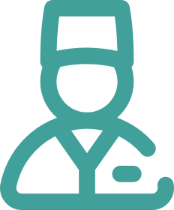查看更多
密码过期或已经不安全,请修改密码
修改密码
壹生身份认证协议书
同意
拒绝

同意
拒绝

同意
不同意并跳过





Thomas Powels:
ctDNA对我来说,定义了膀胱癌的新篇章。
大家好,我是Tom Powles。我从事尿路上皮癌和膀胱癌的药物研发工作。今天想和大家探讨尿路上皮癌中的循环肿瘤DNA。我们近期发布了一项辅助治疗环境下患者的积极试验结果。该试验将ctDNA阳性患者随机分配至阿替利珠单抗组或安慰剂组,结果显示试验组在生存期方面具有显著优势。
那么问题来了,我们该如何实现这一目标,接下来又会发生什么呢?循环肿瘤DNA分析有两种类型。第一种是采用知情方法,将肿瘤捣碎,追踪血液中肿瘤的突变。这就是所谓的知情方法。第二种是Panel筛选方法,即在血液中寻找突变。目前看来,知情方法更为准确,不过这一领域的变化非常快。今天,我将专门讨论知情方法。
And so the question is, how do we get there and what happens next? There are two types of circulating tumour DNA analysis. The first is using an informed approach where you mash up the tumour, you track the mutations from the tumour in the blood. It's called an informed approach. And the second is a panel-based approach where you just look for mutations in the blood. It looks like the informed approach is more accurate at the moment, although the field is changing very rapidly. I'm going to focus exclusively on that informed approach today.
我们目前知道些什么?在一项名为IMvigor010的研究中,这是一项辅助研究。该研究的无进展生存期和总生存期均为阴性。但我们在手术后测量了循环肿瘤 DNA,结果显示约 40% 的高危患者呈阳性。我们随后观察了这些阳性患者的结果。如果是阳性,复发的几率约为95%。如果是阴性,则只有 25% 左右。因此ctDNA具有很强的预后性。我们还在探索性数据中显示,在阳性组中接受阿替利珠单抗治疗的患者总体生存存在获益。这促使我们继续进行IMvigor011研究。
What do we know so far? Well, in a study called IMvigor010, it was an adjuvant study. It was a negative study for progression-free survival and overall survival. But we measure circulating tumour DNA post-surgery and we showed about 40% of high-risk patients were positive. We then looked at the outcome of those positive patients. And if you were positive, you had about a 95% chance of relapsing. If you were negative, it was only about 25%. So strongly prognostic. We also showed in exploratory data that those patients that got a atezolizumab in that positive group had an overall survival benefit. That prompted us to move on and inform and perform IMvigor011 study.
但在此之前,我想先谈谈另外两项研究。第一项是 TOMBOLA试验。TOMBOLA试验追踪了辅助治疗和新辅助治疗阶段的循环肿瘤DNA。结果显示,新辅助治疗阶段的ctDNA清除率很高。但同时也表明,如果对术后阴性患者进行追踪,保持阴性的患者预后极佳。因此,这同样具有很强的预后意义。最后一项试验是 NIAGARA 研究。NIAGARA是一项在膀胱根治术术前进行新辅助化疗,联合或不联合围术期度伐利尤单抗的新辅助研究。该试验的总生存呈阳性结果。因此,围手术期度伐利尤单抗加化疗是一种标准的治疗方法。但实际上,循环肿瘤DNA数据的有趣之处还在于其他原因。首先,它显示在新辅助化疗前的基线,60%的患者ctDNA呈阳性。这一比例在膀胱根治术前降至22%,膀胱根治术后仅为9%。研究还显示,联合度伐利尤单抗与更高的 ctDNA 清除率有关。此外,耐人寻味的是,在所有这些时间点上,度伐利尤单抗治疗组的表现都优于化疗组。因此,该试验告诉我们,ctDNA 在每个时间点都有很强的预后作用。它还告诉我们,联合度伐利尤单抗后,ctDNA 清除率更高。
But before I get there, I want to talk about two other studies. The first is the TOMBOLA trial. The Tombola trial tracked circulating tumour DNA, both in the adjuvant and the neoadjuvant space. It showed high ctDNA clearance in the neoadjuvant space. But it also showed that if you track negative patients post-surgery, those patients who remain negative have an excellent outcome. So again, strongly prognostic. And then the last trial is the NIAGARA study. NIAGARA is a neoadjuvant study of neoadjuvant chemotherapy plus or minus perioperative durvalumab prior to cystectomy. That trial was positive for overall survival. So perioperative durvalumab plus chemotherapy is a standard of care. But the circulating tumour DNA data actually was interesting for other reasons. Firstly, it showed at baseline prior to neoadjuvant chemotherapy, 60% of patients were ctDNA positive. That dropped to 22% prior to cystectomy and only 9% post cystectomy. It also showed the addition of durvalumab was associated with higher ctDNA clearance rates. And it also and intriguingly showed throughout all of these time points, the durvalumab arm performed better than the chemotherapy arm. So what that trial told us is that ctDNA was strongly prognostic at each of these time points. It also told us that the addition of durvalumab resulted in more ctDNA clearance.
IMvigor011--
能帮助我们筛选需要辅助治疗的患者吗?
于是IMvigor011进入我们的视野。IMvigor011是一项什么样的试验?在这项试验中,膀胱根治术后ctDNA阳性或ctDNA阳性的患者被随机分配到安慰剂或阿替利珠单抗。主要终点是无进展生存期,次要终点是总生存期。如果试验结果呈阳性会怎样?那么,在辅助治疗中,我们可能会说,让我们优先考虑那些ctDNA阳性的患者,而搁置那些ctDNA阴性的患者,而不是给未经选择的患者使用纳武利尤单抗。找出需要治疗的患者,放过不需要治疗的患者,这似乎很有吸引力。IMvigor011不会告诉我们的是,我们是否可以在新辅助围手术期度伐利尤单抗和化疗后停止度伐利尤单抗的辅助治疗。IMvigor011旨在告诉我们何时应该开始辅助治疗,而不是何时可以停止新辅助治疗。我们希望这项试验的结果能很快出来。
So that takes us to IMvigor011. What does IMvigor011 look like as a trial? Well, in this trial, patients who were ctDNA positive post cystectomy or became positive post cystectomy and patients were tracked for a year were randomised to placebo or atezolizumab. The primary endpoint is progression free survival with overall survival as the secondary endpoint. What will happen if that trial is positive? Well, it's possible in the adjuvant setting, instead of giving the nivolumab to unselected patients, we may say let's prioritise those patients who were ctDNA positive and spare those patients, who were ctDNA negative. The identification of patients who need therapy and sparing patients that don't, appears attractive. What IMvigor011 will not tell us is whether or not we can stop the adjuvant period of durvalumab after neoadjuvant perioperative durvalumab and chemotherapy. IMvigor011 is designed to tell us when we should start adjuvant therapy, not when we can stop neoadjuvant therapy. The results of this trial we hope will come out very soon.
未来还将有其他试验,如 MODERN 试验,该试验正在研究 抗LAG3抗体联合纳武利尤单抗与单用纳武利尤单抗, 以 ctDNA 清除率为终点的试验确实令人兴奋。但正如我们在新辅助治疗中看到的那样,我希望看到再维恩妥尤单抗联合帕博利珠单抗的试验(EV-303/304)和EV-Durvalumab-Tremelimumab的试验(VOLGA)在围手术期环境中显示出单用系统性疗法对 ctDNA 的高系统清除率。这是一个非常激动人心的时刻。我认为我们将更多地使用ctDNA,而不再通过影响学来决定何时开始治疗。对我来说,这定义了这种疾病的新篇章。而ctDNA、尿液肿瘤DNA和新型疗法,如EV+Pembro DV+Toripalimab在围手术期的应用联合在一起,我认为这将会治愈患者。
There are other trials in the future such as the MODERN trial which is looking at LAG3 (relatlimab) plus nivolumab versus nivolumab alone with ctDNA clearance as the endpoint as really exciting but also as we've seen in the neoadjuvant setting, I'd like to see the EV PEMBRO trials and the EV DURVA TREMI trials in the perioperative setting showing really high systemic clearance rate of CT DNA with systemic therapy alone. It's a really exciting time. I think we're going to be using a lot more ctDNA and a lot less radiology to determine when we start therapy in the future. It for me defines a new chapter in this disease, and ctDNA, urinary tumour DNA and novel therapies such as EV PEMBRO or DV Toripalimab in the perioperative space together I think will cure patients.
Many thanks.
非常感谢。
来源:TomPowles微信公众号
查看更多